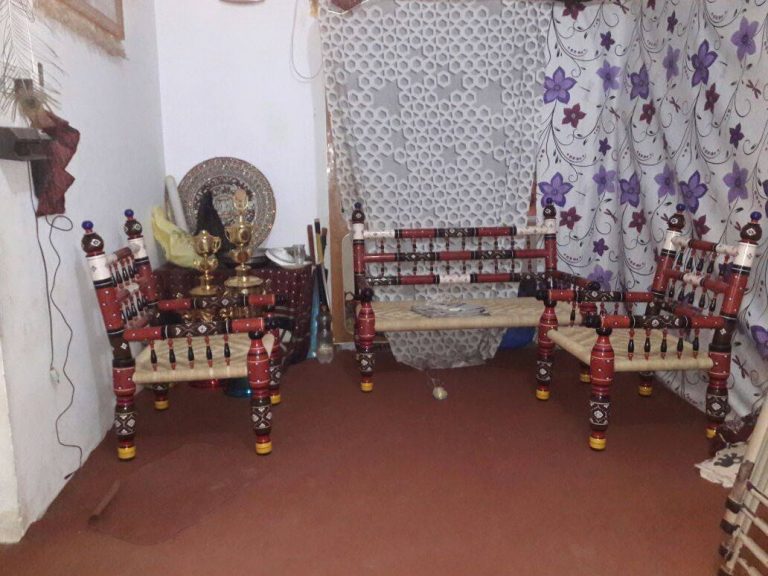
The traders, selling lacquer work items at higher rates in the market, do not pay craftsmen sufficiently.
Muhammad Habib Sanai
Hala is also famous for variety of Handicrafts it produces. These include Jandi (lacquer work), Kaashi (Glazed tile and pottery work), Ajrak, and Susi and Khaadhi (Special cloth).
In this write up an attempt has been made to assess the present status of craft of Jandi and measure the plight of craftsmen engaged in the manufacture of that handicrafts.
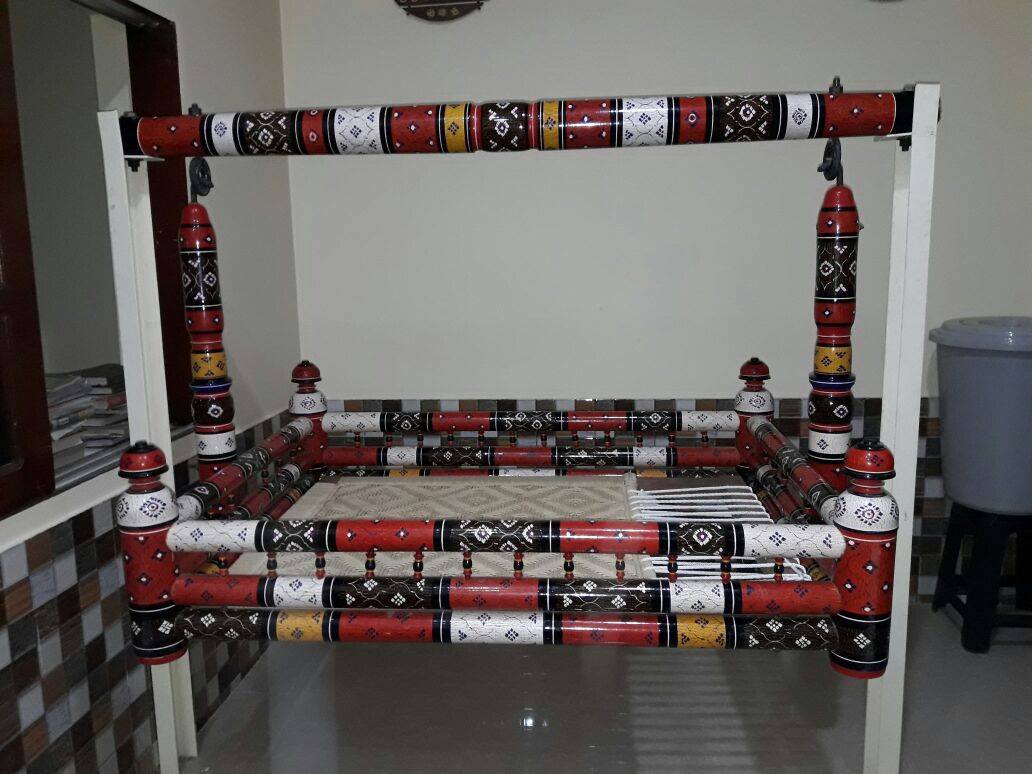 Mr. A.W Hughes, in his book “The Gazetteer of Sindh” first published in 1876, writes that ‘the Hala District is noted also for another manufacture – that of lacquered ware. Of this work, the rings for table napkins, work boxes, pen, cases, rulers, vases, flower-stands, boxes with flat or rounded tops in nests, and a variety of other articles, are made chiefly in the town of Khanoth. The legs of charpais (or native bedsteads) are also lacquered. The wood of which these articles are made, and on which the lacquer is laid, is from the bahan tree and is remarkable for its lightness.’ (p. 219)
Mr. A.W Hughes, in his book “The Gazetteer of Sindh” first published in 1876, writes that ‘the Hala District is noted also for another manufacture – that of lacquered ware. Of this work, the rings for table napkins, work boxes, pen, cases, rulers, vases, flower-stands, boxes with flat or rounded tops in nests, and a variety of other articles, are made chiefly in the town of Khanoth. The legs of charpais (or native bedsteads) are also lacquered. The wood of which these articles are made, and on which the lacquer is laid, is from the bahan tree and is remarkable for its lightness.’ (p. 219)
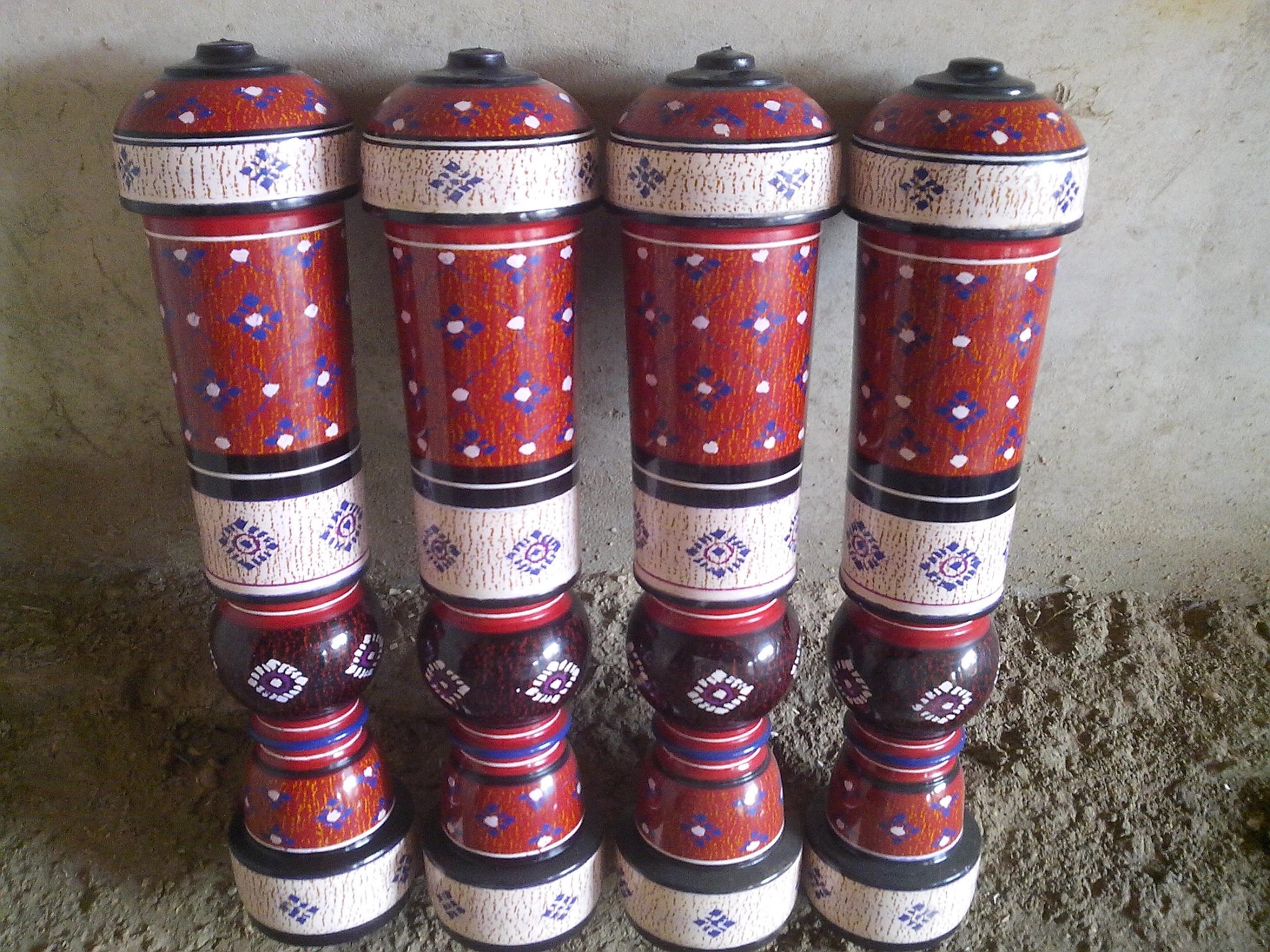 Nowadays, main center is Artisan Colony of Bhit Shah, where craftsmen from Khanoth and Hala Old were settled during early eighties when Govt. of Sindh gave them residential quarters and workshops. However, still there are artisans working in Khanoth and Hala Old.
Nowadays, main center is Artisan Colony of Bhit Shah, where craftsmen from Khanoth and Hala Old were settled during early eighties when Govt. of Sindh gave them residential quarters and workshops. However, still there are artisans working in Khanoth and Hala Old.
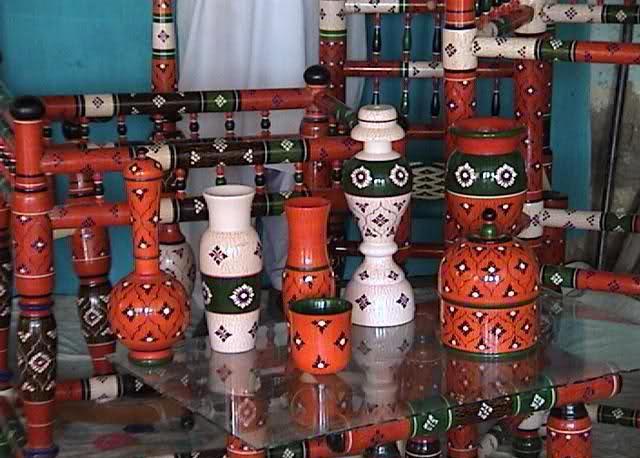 How Jandi item is made
How Jandi item is made
According to Mr. Jam Mitho Khan Bhutto, Pride of Performance award holder artisan, an item of Jandi is finished after going through the thirteen steps, which are briefly discussed below:
As a first step, raw wood is cut into pieces according to the requirement of an item to be prepared. In the second step, the chopped wood is chiseled to convert it in a required mold. In third step, requisite design is carved with the help of equipment called Nahoo. Fourth step is called Maath in Sindhi, wherein design is more refined and unnecessary portions of wood are removed with the help of Poe ranbhow. During fifth step, first coat of any color is applied. In sixth step, second coat of color, mostly yellow, is applied. Seventh step is especially done at Hala, wherein rogani work (dots of yellow color are made) is done. This step is also called Janhwar. In the next step, black or any other color is applied. In ninth step, with the help of richhi, designs of flowering are carved. In the tenth step, color is applied on this engraved flowering. In the eleventh step, unnecessary color coat is removed, so that design could be made clear. In the twelfth step, with help of oil, cotton cloth, glittering is created. In the last step, which is called Boraki, unnecessary wood in the middle of item is removed.
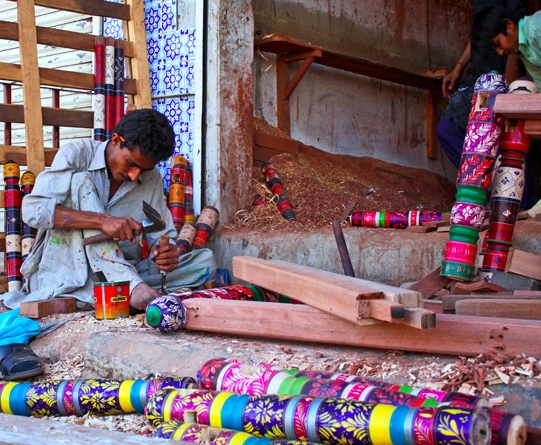
Problems of craftsmen
At present 100 craftsmen are engaged in production of lacquer work.
As income of artisans is not sufficient to meet even their basic needs of food and clothing, they take loans from the seths or middlemen. As a result, majority of them owe 30 to 40 thousand to these seths or middlemen.
Mr. Muhammad Soomar, an artisan based at Khanot, informed me that the menace of indebtedness started fifteen years ago, when nearby forest was completely decimated and they started to purchase wood from far off sites. As Craftsmen did not have sufficient cash or enough space to procure the wood in large quantity and store it, so seths or middlemen arose, who arranged wood and gave loans to artisans.
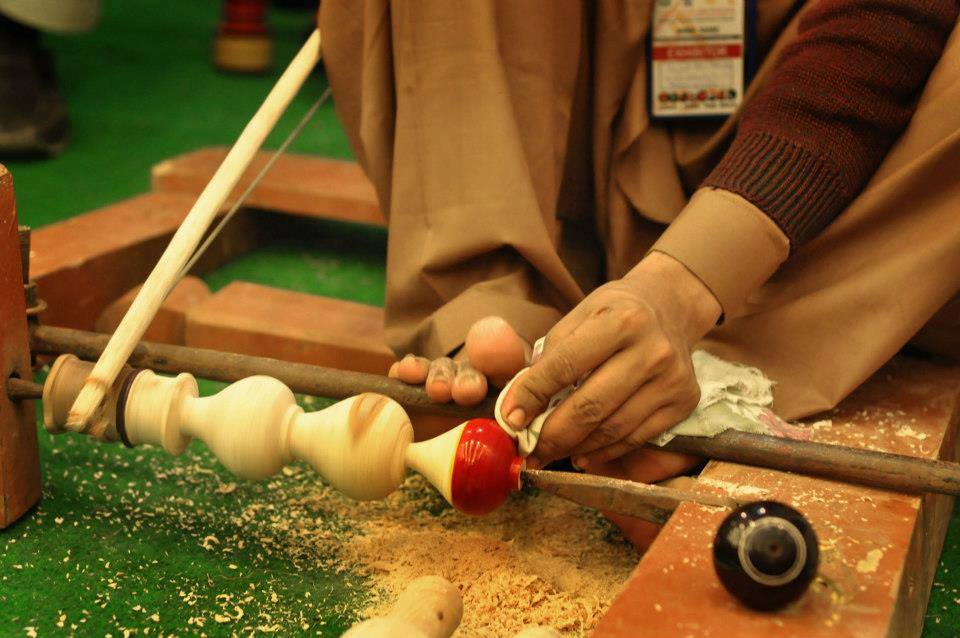
Economics of some prominent articles
To measure the plight of artisan in monetary terms, it would be appropriate if we give the economics of making few well known items.
One artisan can make one Swinging cot or cradle in one month. As wood is supplied by the trader/middleman, therefore, he is paid only Rs.6000 for labor and also for reimbursement of expenses incurred on purchase of color, coal etc. It is estimated that around Rs.2000 are incurred on procurement of color and coal etc. Therefore, his net income becomes only 4000 thousand, if he is engaged to make a swinging cot.
The same thing is sold in market by trader at the price ranging between Rs.18, 000 to 20,000 whereas his investment is around 11,000. His profit remains around 40 per cent.
Another running item is Sofa Set. One craftsman takes twenty days to make one set. For this he is paid only 4000, which also include the expenses incurred on purchase of color, coal etc. by him. As such, he receives around two thousand as labor charges.
The same sofa is sold in market at the price ranging from rupees 12 to 15 thousand by the trader, whose investment is around 7500.
What Traders and others say
But traders put forward different reasons. They claim that artisans do not complete ordered items on time and if left on their own, use substandard raw material, therefore, quality of output becomes questionable.
Few residents of Khanoth opined that these artisans do not work regularly and also misuse the loan amount.
Some social scientists suggest that as these craftsmen do not receive good incomes despite their hard labor, so they become alienated and became non-serious in their performance.
It may be noted that this art is transferred from one generation to another generation. But now new generation is not being involved and taught this skill, because this work does not provide gainful employment. Therefore, it is feared that after few years, there will be no Jandi artisan.
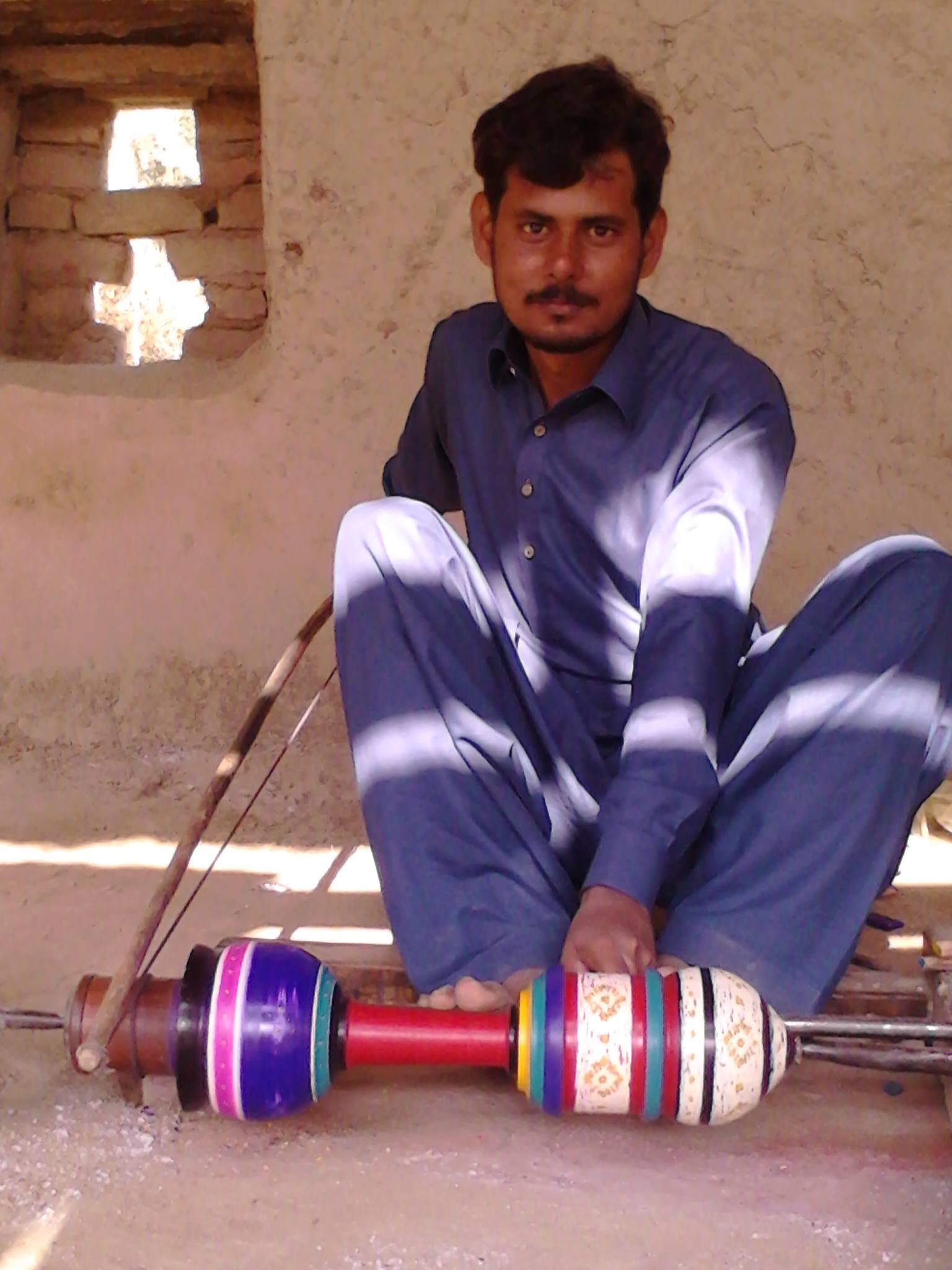
Recommendations
- Nurseries of Bahan trees may be developed in Khanoth so that Jandhi worker can get wood at competitive rates.
- Display and sale centers may be established near workshops and markets to be managed by persons chosen by artisans.
- Technical support in product diversification and designs may be provided to revive old designs and market demand items.
- Loan on soft terms may be advanced to get various artisans free from the shackles of loans.
- Artisans may be given medical facilities and health insurance cover.
- An institutional arrangement may be devised for monthly payment to artisans when they retire.
- Artisans should also be trained in making their trade associations, so that can do export trade with the exploitation of traditional exporters.
- Technical support and training in devising new design procedure to make furniture items detachable and easy transportable. And Trainings in making proper packing and packaging may also be arranged.
___________________
 The author is a freelance writer based in Hala town of Sindh. He can be reached at habibsanai@hotmail.com
The author is a freelance writer based in Hala town of Sindh. He can be reached at habibsanai@hotmail.com
All Photos Courtesy: Facebook